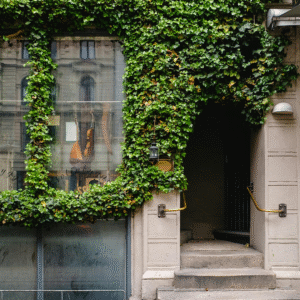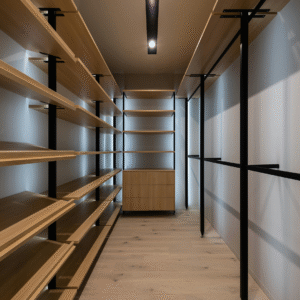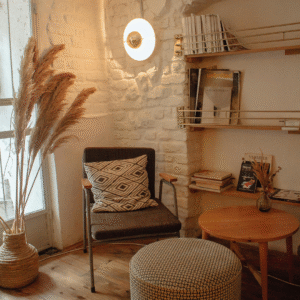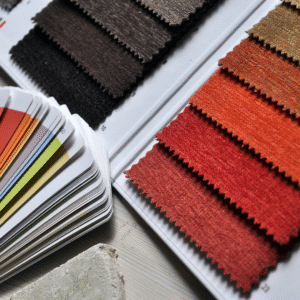The year 2025 is witnessing a dynamic shift in interior design, blending tradition with innovation, and comfort with functionality. As urban living spaces evolve, homeowners and designers are embracing trends that reflect a deeper connection to nature, culture, and technology. Here’s a look at the top five interior design trends making waves this year:
Biophilic Design: Bringing Nature Indoors

In 2025, biophilic design has transcended being a mere trend to become a foundational approach in interior design, especially in urban Indian homes. This philosophy emphasizes the intrinsic human connection to nature, advocating for interiors that promote well-being, sustainability, and a harmonious balance with the environment.
Indoor Gardens & Vertical Green Walls
Urbanization often limits green spaces, but innovative solutions like indoor gardens and vertical green walls are bridging this gap. These installations not only purify indoor air but also serve as natural sound absorbers and mood enhancers. In cities like Bengaluru and Mumbai, architects are transforming balconies and living rooms into lush green sanctuaries, utilizing modular systems and hydroponic setups to cultivate a variety of plants, from ornamental greens to edible herbs.
For instance, Dhwani Patel Designs showcases how vertical gardens can be seamlessly integrated into modern interiors, creating a serene ambiance that fosters relaxation and productivity.
Natural Light Maximization
Natural light is a cornerstone of biophilic design. In 2025, there’s a marked shift towards architectural elements that enhance sunlight penetration. Features like floor-to-ceiling windows, skylights, and strategically placed mirrors are becoming commonplace, ensuring spaces are bathed in natural light throughout the day. This not only reduces reliance on artificial lighting but also aligns with India’s traditional architectural principles that emphasize the importance of natural elements in living spaces.
Designers are also incorporating smart technologies, such as automated window blinds and light sensors, to optimize light intake while maintaining energy efficiency.
Use of Natural Materials
The tactile experience of natural materials plays a pivotal role in biophilic design. In 2025, there’s a resurgence in the use of indigenous materials like terracotta, reclaimed wood, and bamboo. These materials not only add aesthetic value but also support sustainable practices by reducing the carbon footprint associated with construction.
For example, HM Constructions emphasizes the integration of local materials in their projects, aligning with the growing demand for eco-friendly and culturally resonant interiors.
Integration of Local Flora and Cultural Elements
Indian biophilic design uniquely incorporates native flora and cultural motifs. Plants like hibiscus, marigold, and jasmine are favored for their vibrant colors and aromatic properties. Additionally, elements such as stone jaali screens, carved wooden panels, and traditional clay tiles are being reintroduced, blending modern aesthetics with cultural heritage.
This fusion not only enhances the visual appeal of interiors but also fosters a deeper connection to India’s rich architectural and botanical heritage.
2. Smart Homes & Technology Integration

In 2025, the fusion of technology with interior design has transformed homes into intelligent, responsive living spaces. This integration not only enhances convenience and efficiency but also elevates the overall living experience by seamlessly blending aesthetics with functionality.
Voice-Activated Systems: Commanding Comfort
Voice-controlled assistants like Amazon Alexa, Google Assistant, and Apple Siri have become central to modern homes. These systems allow homeowners to control lighting, temperature, security features, and entertainment systems through simple voice commands. In Indian homes, this technology is particularly beneficial for elderly residents or those with mobility challenges, providing them with greater independence and ease of access.
For instance, WeDezine Studio emphasizes the importance of integrating voice-activated systems into interior design, ensuring that technology enhances rather than disrupts the home’s aesthetic appeal.
Automated Furnishings: Furniture That Adapts
The concept of smart furniture has evolved beyond mere convenience to become a blend of luxury and functionality. Adjustable smart beds that monitor sleep patterns, app-controlled recliners and sofas for customizable comfort, and height-adjustable desks that promote ergonomic health are becoming staples in modern interiors. These pieces not only optimize space but also cater to the dynamic needs of contemporary lifestyles.
Designers are focusing on creating furniture that is both technologically advanced and stylistically cohesive, ensuring that these pieces complement the overall design theme of the space.
Energy-Efficient Solutions: Sustainable Living
With the growing emphasis on sustainability, smart home technology offers solutions that promote energy efficiency. Smart thermostats learn user preferences and adjust heating or cooling accordingly, reducing energy consumption. Similarly, smart lighting systems can be programmed to turn off when no one is in the room or adjust brightness based on natural light levels, contributing to lower electricity bills and a reduced carbon footprint.
Incorporating these technologies aligns with India’s commitment to sustainable development and offers homeowners a way to contribute to environmental conservation while enjoying modern comforts.
Smart Security Systems: Enhanced Protection
Security is a paramount concern for homeowners, and smart technology provides advanced solutions to address this. Biometric locks, facial recognition systems, and smart cameras offer enhanced security features that can be monitored remotely. These systems not only provide peace of mind but also integrate seamlessly into the home’s design, ensuring that aesthetics are not compromised.
Designers are working closely with technology providers to ensure that security features are both effective and unobtrusive, maintaining the home’s visual appeal without sacrificing safety.
Seamless Integration: Technology as a Design Element
One of the key challenges in integrating smart technology into interior design is ensuring that devices blend seamlessly with the space’s aesthetics. The days of bulky, visible wiring and unattractive devices are long gone. Today, smart home products are designed to be sleek, minimalistic, and unobtrusive, allowing them to complement a wide variety of interior styles.
At WeDezine Studio, the focus is on creating spaces where technology enhances the living experience without overshadowing the design elements. This approach ensures that smart devices become an integral part of the home’s decor, providing functionality without compromising on style.
Conclusion
The integration of smart technology into interior design is not just about convenience; it’s about creating spaces that are responsive, efficient, and aligned with the needs of modern living. As we move further into 2025, the trend towards intelligent homes continues to grow, offering homeowners a way to enhance their living environments through thoughtful design and innovative technology.
For more insights into integrating smart technology into your home, consider exploring the works of leading design firms such as WeDezine Studio and Stories Design Studio, who are at the forefront of this transformative trend.
3. Multifunctional & Flexible Spaces

In 2025, the demand for adaptable living spaces has reached new heights, driven by the rise of remote work, smaller urban homes, and a desire for multifunctional environments. This trend emphasizes the creation of interiors that seamlessly transition between various functions without compromising on style or comfort.
Modular Furniture: Customizable Comfort
Modular furniture stands at the forefront of this transformation. These pieces are designed to be reconfigured to suit different needs, making them ideal for dynamic living situations. For instance, modular sofas can be rearranged to accommodate guests or transformed into beds for overnight stays. Similarly, modular storage units can be expanded or contracted based on storage requirements.
Designers are increasingly focusing on creating modular pieces that are not only functional but also aesthetically pleasing. The use of high-quality materials and thoughtful design ensures that these pieces complement the overall decor of the space.
Open-Plan Layouts: Fluid Living Spaces
Open-plan layouts continue to dominate interior design in 2025, offering flexibility and a sense of spaciousness. These layouts allow for easy transitions between different areas of the home, such as the living room, dining area, and kitchen. To define distinct zones within an open-plan space, designers are employing techniques like area rugs, lighting variations, and movable partitions.
This approach is particularly beneficial for urban dwellers who need to maximize limited space. It enables homeowners to create multifunctional areas that can serve as workspaces, relaxation zones, or entertainment hubs, depending on the time of day and specific needs.
Smart Storage Solutions: Decluttering with Style
Efficient storage solutions are essential in multifunctional spaces. In 2025, there’s a growing emphasis on smart storage options that help maintain a clutter-free environment. Furniture pieces with built-in storage, such as ottomans with hidden compartments or beds with drawers, are becoming increasingly popular.
Additionally, vertical storage solutions, like wall-mounted shelves and tall cabinets, are being utilized to make the most of available space. These solutions not only provide ample storage but also contribute to the overall aesthetic of the room by keeping essentials organized and out of sight.
Adaptable Design for Evolving Needs
The key to successful multifunctional design lies in adaptability. As lifestyles continue to evolve, so do the requirements of living spaces. Designers are focusing on creating environments that can easily adapt to changing needs, whether it’s accommodating a growing family, transitioning from a home office back to a guest room, or reconfiguring a space for different activities.
This adaptability is achieved through the use of versatile furniture, flexible layouts, and thoughtful design elements that allow for easy modifications. The goal is to create spaces that can evolve alongside the occupants’ needs, ensuring long-term functionality and comfort.
Conclusion
The trend towards multifunctional and flexible spaces in 2025 reflects a shift towards more adaptable, efficient, and personalized living environments. By incorporating modular furniture, open-plan layouts, smart storage solutions, and adaptable design elements, homeowners can create spaces that cater to their evolving needs without compromising on style or comfort.
For more insights into creating multifunctional spaces, consider exploring the works of leading design firms such as Shardes Interiors and WeDezine Studio, who are at the forefront of this transformative trend.
4. Artisanal & Handcrafted Elements

In 2025, there’s a resurgence of appreciation for traditional craftsmanship in interior design. Homeowners and designers are increasingly drawn to artisanal and handcrafted pieces that not only add character and cultural depth to spaces but also support local artisans and preserve heritage crafts. This trend emphasizes the value of individuality and the stories behind each piece, creating interiors that are both meaningful and unique.
Bespoke Furniture: Custom-Made for Character
Bespoke furniture pieces are gaining popularity as they offer a personal touch and reflect individual style and heritage. Whether it’s a hand-carved wooden chest from Rajasthan or a custom-made teakwood bookshelf, these pieces serve as focal points in a room, adding warmth and authenticity. Designers are collaborating with local artisans to create furniture that blends traditional techniques with contemporary aesthetics, resulting in pieces that are both functional and artistic.
For instance, Studio Raw Material in Rajasthan transforms stone scrap into sculptural furniture and fixtures, applying traditional techniques to create modern designs. Their work exemplifies the fusion of craftsmanship and innovation, offering unique pieces that tell a story.
Cultural Artifacts: Integrating Traditional Art Forms
Incorporating traditional Indian art forms into interior design adds a rich cultural layer to spaces. Madhubani paintings, Pattachitra art, and Warli murals are being used as statement pieces on walls, bringing vibrant colors and intricate patterns into homes. These artworks not only enhance the aesthetic appeal but also connect the space to India’s diverse artistic heritage.
For example, The Workroom highlights the integration of traditional art forms into modern interiors, showcasing how these artworks can serve as conversation starters and cultural touchpoints in contemporary homes.
Handwoven Textiles: Weaving Tradition into Modern Living
Handwoven textiles such as dhurries, kantha quilts, and ikat cushions are being used to infuse spaces with texture and color. These textiles, often crafted using age-old techniques, add a tactile richness to interiors and serve as a testament to India’s rich textile heritage. Designers are incorporating these pieces into modern settings, creating a harmonious blend of tradition and contemporary design.
The Hindustan Times provides insights into how traditional fabrics and textiles can be used to update home warmth and cultural elements, offering tips on layering cushions, throws, and using sarees as elegant curtains.
Upcycled Artifacts: Giving New Life to Traditional Pieces
Upcycling traditional artifacts is an innovative way to preserve heritage while adapting to modern needs. Items like old stone sculptures from Orissa or Rajasthan can be repurposed into functional pieces such as table lamps or decorative accents. This approach not only reduces waste but also adds a unique character to interiors, blending the old with the new.
Designers are creatively transforming these artifacts, ensuring that they retain their cultural significance while serving contemporary purposes. This practice supports sustainable living and promotes the appreciation of traditional craftsmanship.
Conclusion
The incorporation of artisanal and handcrafted elements into interior design in 2025 reflects a broader movement towards sustainability, individuality, and cultural appreciation. By embracing bespoke furniture, traditional art forms, handwoven textiles, and upcycled artifacts, homeowners can create spaces that are not only aesthetically pleasing but also rich in heritage and meaning. This trend fosters a deeper connection to craftsmanship and supports the artisans who keep these traditions alive.
For more insights into integrating traditional Indian crafts into modern interiors, consider exploring the works of design firms such as The Workroom and Studio Raw Material, who are at the forefront of this transformative trend.
5. Bold & Vibrant Color Palettes

In 2025, interior design is embracing a departure from the subdued neutrals of previous years, ushering in a vibrant and expressive palette that infuses spaces with energy, warmth, and individuality. This shift reflects a broader desire for interiors that not only serve functional purposes but also evoke emotion and personality.
Deep Greens & Forest Tones: A Nod to Nature
Deep greens and forest tones are making a significant comeback, inspired by the lush landscapes of India and a growing emphasis on biophilic design. These shades create a serene and grounded atmosphere, promoting relaxation and a connection to nature. Whether used on accent walls, upholstery, or decorative elements, deep greens bring a sense of tranquility and depth to interiors.
Designers are pairing these tones with natural materials like wood and stone to enhance the earthy vibe. Incorporating plants and greenery further complements the natural aesthetic, creating a harmonious and rejuvenating environment.
Terracotta & Mustard Yellows: Warmth and Energy
Terracotta and mustard yellows are infusing interiors with warmth and energy. These earthy hues, reminiscent of Indian clay and spices, add a cozy and inviting feel to spaces. Terracotta, with its rich, sun-baked undertones, is perfect for creating a grounded and organic vibe, while mustard yellow brings a cheerful and uplifting touch.
These colors are being used in various ways, from feature walls and furniture to textiles and accessories. When combined with neutral tones and natural textures, they create a balanced and harmonious look that is both vibrant and soothing.
Oxblood Red: Luxury and Sophistication
Oxblood red, a deep reddish-brown hue with nuances of burgundy and purple, has emerged as a luxurious and sophisticated choice in interior design. Inspired by Pantone’s Mocha Mousse (Pantone 17-1230), this color symbolizes comfort and indulgence, resonating strongly with homeowners seeking a refined aesthetic.
Interior designers are incorporating oxblood red in materials like plush velvet, rich wood tones, and marble accents. Suggestions for using this shade include painting feature walls, upholstering furniture, and adding decorative elements like cushions and rugs. The versatility of oxblood red allows it to complement various design styles, from traditional to contemporary, adding depth and elegance to any space.
Conclusion
The bold and vibrant color palettes of 2025 are redefining interior design by infusing spaces with personality, warmth, and a connection to nature. By incorporating deep greens, terracotta, mustard yellows, and oxblood red, homeowners can create interiors that are not only visually striking but also emotionally resonant. These colors, when thoughtfully applied, transform living spaces into personalized sanctuaries that reflect individual tastes and lifestyles.
For more insights into integrating these vibrant hues into your home, consider exploring the works of leading design firms such as Studio Raw Material and WeDezine Studio, who are at the forefront of this transformative trend.
